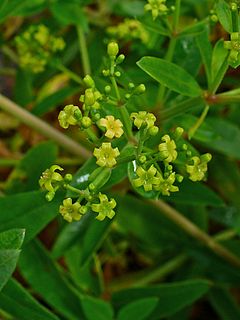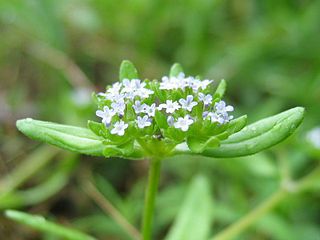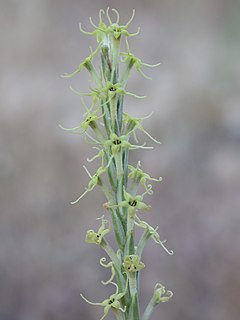
Rubia is a genus of flowering plants in the family Rubiaceae. It contains around 80 species of perennial scrambling or climbing herbs and subshrubs native to the Old World. The genus and its best-known species are commonly known as madder, e.g. Rubia tinctorum, Rubia peregrina, and Rubia cordifolia.

Genista is a genus of flowering plants in the legume family Fabaceae, native to open habitats such as moorland and pasture in Europe and western Asia. They include species commonly called broom, though the term may also refer to other genera, including Cytisus and Chamaecytisus. Brooms in other genera are sometimes considered synonymous with Genista: Echinospartum, Retama, Spartium, Stauracanthus, and Ulex.

Polygonum is a genus of about 130 species of flowering plant in the buckwheat and knotweed family Polygonaceae. Common names include knotweed and knotgrass. In the Middle English glossary of herbs Alphita, it was known as ars-smerte. There have been various opinions about how broadly the genus should be defined. For example, buckwheat has sometimes been included in the genus as Polygonum fagopyrum. Former genera such as Polygonella have been subsumed into Polygonum; other genera have been split off.

Indigofera is a large genus of over 750 species of flowering plants belonging to the pea family Fabaceae. They are widely distributed throughout the tropical and subtropical regions of the world.

The plant tribe Phaseoleae is one of the subdivisions of the legume subfamily Faboideae, in the unranked NPAAA clade. This group includes many of the beans cultivated for human and animal food, most importantly from the genera Glycine, Phaseolus, and Vigna.

Asperula, commonly known as woodruff, is a genus of flowering plants in the family Rubiaceae. It contains about 195 species and has a wide distribution area from Europe, northern Africa, temperate and subtropical Asia to Australasia.

Pluchea is a genus of flowering plants in the stinkwort tribe within the sunflower family.

Valerianella is a genus of plant in family Caprifoliaceae. Many plants of this genus are known by the common name corn salad or cornsalad, although that name most often refers to Valerianella locusta.

Crucianella is a genus of flowering plants in the family Rubiaceae. The species are annual herbs found from the Mediterranean to Central Asia and the Arabian Peninsula. One species is naturalized in northern California, southern Oregon, and Idaho.
Plocama puberula is a species of flowering plant in the family Rubiaceae. It is endemic to the Socotra archipelago of Yemen. Its natural habitat is rocky areas.
Plocama thymoides is a species of flowering plant in the family Rubiaceae. It is endemic to the Socotra archipelago of Yemen, where it occurs in semi-deciduous woodland habitat. It is listed as an endangered species by the IUCN under the basionym Gaillonia thymoides.
Plocama tinctoria is a species of flowering plant in the family Rubiaceae. It is endemic to northern Somalia and the Socotra archipelago of Yemen. Its natural habitat is subtropical or tropical dry forests. It is listed by the IUCN as a threatened species under the basionym Gaillonia tinctoria.

Dirichletia is a genus of flowering plants in the family Rubiaceae. The genus is found northeastern tropical Africa to Namibia.

Hypericum sect. Adenosepalum is one of 36 sections in the genus Hypericum. Its type species is Hypericum montanum.
Plocama rosea, is a species of flowering plant in the family Rubiaceae. It is native to Iran, Afghanistan, and Pakistan. It was formerly recognized as Aitchisonia rosea, which was the only species in the now synonymized genus Aitchisonia.











